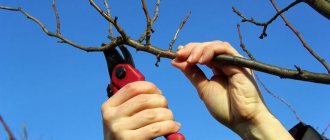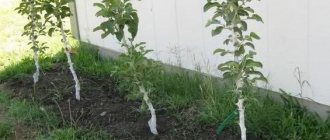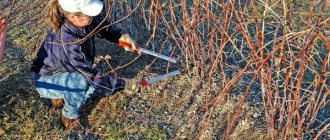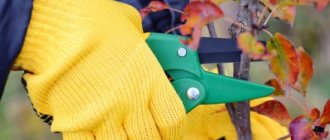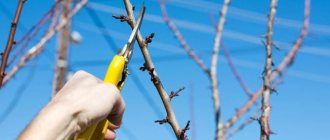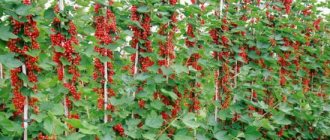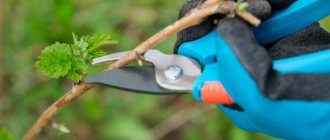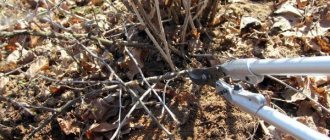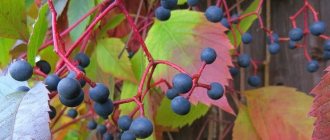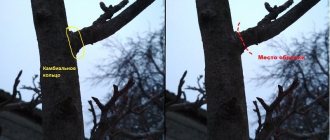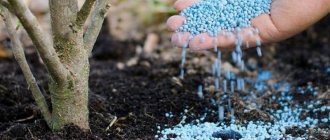- Why does a young pear grow branches from below?
Spring and autumn pruning of pear trees allows you to form a crown and rejuvenate the tree. For good fruiting, a pear needs a large amount of sunlight, and heavily dense branches shade the ripening fruits located lower in the tier and closer to the trunk.
How pruning affects the health and fruiting of pears
The procedure allows the gardener to influence several life cycles of the tree at once:
- regulates growth force;
- prolongs life and fruiting;
- improves fruit quality;
- increases the amount of harvest;
- accelerates the onset of fruiting.
Pruning a pear tree can be:
- formative,
- supportive,
- rejuvenating.
You need to start forming a tree from the first year after planting. During the manipulation process, the foundation of the future crown is laid and the growth of fruit-bearing branches is stimulated. Crown shaping involves minimal removal of lateral branches before the age of fruiting.
Most gardens in the southern regions of Russia are planted with tree-like pears with a rounded crown type on a seed rootstock. Such trees have a long life cycle, their productive period lasts up to 50 years or even more.
Methods for pruning pears
The main disadvantage of a garden with this type of planting is that the fruit trees grow very tall and are difficult to cultivate. It is impossible to completely harvest a tall pear.
Pruning a pear: when and how to do it correctly
Pruning is carried out in the fall, after the leaves fall, and in the spring, before the buds open.
in spring
Cherry pruning
Spring pruning improves the quality and quantity of the harvest. Diagrams and instructions will tell you how to prune a pear in spring for beginners. Pears are pruned in the spring according to a certain pattern:
- remove excess side branches;
- the trunk is shortened by one-fourth of the height;
- The cutting areas are treated with garden varnish.
Excess lateral branches are removed to limit the growth of unnecessary shoots and direct the maximum amount of nutrients to the fruit-bearing wood.
The trunk is shortened so that the tree does not waste energy on excess growth. It is easier to process and harvest a fruit tree when it is no more than 3-4 m in height.
Important! Untreated sections can become a site for infection to penetrate and spread.
The formation of a pear begins in the first year of the plant’s life. In the second spring after planting, the young tree is shortened so that its height does not exceed 50 cm. Pruning the stem branch allows the seedling to form new lateral fruiting and growth branches from the buds of the lower tiers. At this stage, the correct crown shape is formed, convenient for spraying the plant and collecting fruits.
How to prune a pear in summer
In the summer, fruit trees are pruned by pinching. During the manipulation process, new shoots are pinched, stopping their growth.
Pinching can be done by hand or with pruning shears. The upper part of the shoot is removed in the area covered with hardened crust. After this, the shoots stop growing in length.
Summer pruning of pear
Summer pruning is carried out throughout the season, starting in June. Every 10-14 days, new growth is pinched. Pinching carried out in the summer allows you to direct more nutrients to the formation and ripening of fruits. On branches that have stopped growing, leaf buds transform into fruit buds.
in autumn
In autumn, fruit trees are pruned carefully. Do not remove too many branches at once, otherwise the pear may not survive winter frosts.
At the beginning of autumn, sap flow does not stop, it just stops. After removing part of the side growth, the tree will try to heal the wounds. For regenerative activities, it will spend substances that it has stored for the winter period. If too much is used, the pear tree will die in winter.
Autumn scheme for the formation of a pear crown:
- remove diseased and dry branches;
- saw off vertically growing branches;
- branches growing at an angle of 40° are partially removed.
The branches that are left on the tree are chosen according to the principle: the more horizontal, the better. The fact is that branches with an inclination angle of less than 40° bear fruit poorly, but require a lot of useful substances for their growth.
Important! The side branches are removed by sawing off at the very base. The cut branches are burned and the resulting ash is used as fertilizer.
Sparsely tiered pear crown
This type of green mass is the most common and resembles natural forms. On the trunk, the shoots are arranged in tiers of 2-3 pieces or individually.
Formation of the crown of an annual seedling begins in early spring. For this purpose, a bole zone is allocated on the main conductor. It is located at a distance of 0.5 m from the surface of the earth. If it is smaller, then caring for an adult crop will be problematic. In the case of an enlarged bole, the pear will lose resistance to sub-zero temperatures and sunburn.
Above the trunk, another 30-40 cm must be measured, on which the skeletal shoots of the first tier will be located, and the conductor must be removed. The cut needs to be made above a healthy and developed bud - a shoot will appear from it, a continuation of the trunk. During crowning, the main branch should remain 15-20 cm higher than the shoots growing on the sides.
Another year later in the spring, gardeners clear the trunk of growth. There should be 3 branches left in the first tier, the distance between them along the trunk will be 10-15 cm. Their length is almost the same along the same horizontal line. Their circumferential growth will ideally be 100-120° between themselves. The remaining side shoots must be cut off or bent for a while so that they are parallel to the ground. This approach will slow down their growth, and, on the contrary, increase productivity.
Attention!
Branches whose length does not exceed 30 cm do not need to be removed - fruits will be set on them. They are almost not prone to growth.
On a three-year-old tree, a new one is laid 0.5-0.7 m from the lower tier. It is formed by 2-3 future skeletal shoots. The algorithm is the same as when forming the first tier. If the conductor has grown excessively, then it must be shortened. Branches that have been bent should not be touched. But if they make the crown very thick, then they will have to be shortened or completely removed.
On a four-year-old pear, 40 cm from the second tier, you can leave 2-3 branches of the third level. After 1-2 years, the conductor on the trunk must be shortened to the upper skeletal shoot growing from the side. The crown height should ideally be at least 4-4.5 m.
Pruning old trees
To trim an old tall tree you will need:
- saw;
- pruner;
- ladder;
- composition for treating the cutting area of branches.
Fruit tree pruning
Large tree-like plants are pruned according to two schemes. The first involves removing all fragile and dry branches. Remove those branches that are not able to support the weight of the fruit.
Following the second scheme, only those branches that grow horizontally to the surface of the earth are left on the tree. Trimming fruit trees allows you to get rid of unnecessary growth and direct all the plant’s forces to forming a high-quality and high yield.
Important! After spring pruning, fertilizers with a high nitrogen content should not be used.
Do tops bear fruit?
Many people are interested in whether apples form on top shoots. Branches that grow in a vertical position rarely bear fruit. Therefore, most tops do not form fruits. Their main goal is to restore the normal state of apple trees after damage or disease.
Fruits rarely appear on such branches due to their increased growth. Most of the nutritional components are spent on shoot development, and therefore nothing is left for fruit formation. To force the stems to bear fruit, you will have to bend the shoot for horizontal growth or trim it regularly.
Instructions for beginners: how to trim pears
Pruning red currants in spring
Old and young trees are pruned according to patterns appropriate to their age.
Young seedlings begin to be pruned a short time after transplantation. In this way, the gardener directs more nutrients to the formation of the root system.
The crown is formed annually. To do this, prune the main stem branch by one-fourth of its height in the first year, and then by about 30 cm annually. Pears with a pyramidal crown shape bear fruit well.
Pear pruning
Seedlings two and three years old are pruned in autumn and spring. A four-year-old tree begins to form a second tier of main branches. In the 5th year, the shoots are removed with great care so as not to accidentally cut off the fruit branches.
How to shape a pear older than 10 years? Anti-aging pruning is used for trees of venerable age. During this manipulation, all barren old branches are removed and sawed off at the end of winter at an air temperature of 0°C. This method stimulates the pear tree to grow new branches.
The pear will not produce a bountiful harvest after rejuvenating pruning, but it will still bear fruit for some time.
Types of pruning, timing
There are three types of autumn pruning of pear trees:
- sanitary;
- rejuvenating;
- formative.
Sanitary pruning
This type of pruning is carried out in order to remove damaged, disease-affected and abnormally growing shoots from the tree. The procedure helps to form a neat crown. Sanitary pruning is carried out at any time of the year.
Formative pruning
In spring and autumn it is necessary to get rid of some shoots and some skeletal branches. This procedure also helps improve the breathability of the crown. Autumn processing of fruit trees should be done from the end of August to the end of September. This is the most optimal period for the procedure.
Anti-aging pruning
Old trees need rejuvenation. The pruning process is different in that thick branches are gradually cut out. This is how the old skeleton is replaced by young shoots. First, old dried branches from the tree are cut off, then branches that compete with the main trunk are removed. At the final stage, young shoots are cut off.
Spinning tops on a pear: what to do
The crown of a tree-like fruit plant is molded to preserve nutrients for the fruit branches. Shoots growing vertically upward on the main branch or trunk of a tree are called tops.
A top is a barren shoot that actively grows and draws useful substances onto itself. Young top shoots are disposed of in two ways:
- cutting under the base;
- cultivating by annual pruning and shaping.
Tops are trimmed to the very edge at the point where the branch emerges. After pruning, the wound on the tree is treated with garden varnish, otherwise several new shoots will appear in place of the cut branch.
On pears, the top branches can be pinched rather than cut out. Pinching stops the growth of the branch.
Also, the tops are bent down and included in the tiers of the first and second order. The older the tree gets, the less young shoots it will grow.
The main reasons for the growth of young top branches
Agronomists name three main reasons for the growth of tops on apple trees:
- Damage. These include sunburn and bark frostbite. Also, spiny shoots begin to grow if a large branch breaks off from a tree.
- Incorrect trimming. The tops will grow if the gardener prunes the apple tree incorrectly during anti-aging pruning.
- Nitrogen in fertilizers. Nitrogen fertilizing promotes active growth of branches and leaves. If the gardener exceeds the recommended dose for the tree, hidden buds also bloom.
How to prune young pears correctly
Pruning of young pears begins a week after planting. The main branches that form the skeleton are identified, and all excess is cut out. The stem branch is shortened by one fourth.
Shoots growing below the first tier of skeletal branches are completely removed. The next season, the trunk is shortened by 25 cm, and the skeletal branches are cut by 5-10 cm. When forming the crown, the upper branches are designed so that they are shorter than the lower ones.
Pruning a young pear
Some novice gardeners doubt whether it is possible to shorten the top? If you do not trim the central conductor, the tree will eventually grow too tall. Tall fruit plants are difficult to care for and almost impossible to harvest without loss.
Why does a young pear grow branches from below?
If a young pear tree has overgrowth branches from below, they need to be removed. They cannot be left as they weaken the tree. The appearance of shoots indicates that the pear is experiencing some kind of inconvenience or is sick. The reasons for the appearance of unwanted shoots need to be found out and measures taken to eliminate them.
The most common causes of growth:
- The tree did not survive the winter frosts well. Most often, damage (cracking, freezing) is not immediately visible, but the tree reacted to it in the spring by the appearance of shoots and shoots.
- The bark is propped up at the bottom of the trunk due to improper planting: the tree is planted too deep, or the soil is too wet for fruit crops. In this case, it is too late to re-graft the pear. A new seedling is planted taking into account the mistakes made.
- The shoots begin to grow actively if too many branches were removed during pruning.
- A garter with a label that is not removed from a tree trunk eventually grows and cuts into the bark of the tree. It interferes with normal sap flow, and in response the tree produces shoots.
- Lower branches of a pear are formed if the grafted variety does not get along with the root system. As a result, normal metabolism is disrupted, and the root system does not receive the beneficial substances produced by the foliage.
- Mechanical damage to the bark and breaks of large branches cause a large number of shoots to appear.
- Sprouts appear on a pear tree if the roots come out. The problem is solved very simply: the area around the trunk needs to be covered with a layer of earth.
HOW TO GET RID OF GARDENERS - TIPS AND REVIEWS OF GARDENERS
HOW TO GET RID OF GOLDS
Amateur gardeners ask me: why do so-called tops (fat-bearing shoots) grow on fruit trees?
What is the reason
The most common reason is improper pruning. If you cut a young shoot incorrectly, five or more shoots will grow from it. As a result, the tree becomes like a panicle, that is, it has many leafy shoots that thicken the crown. In this case, do not expect a good harvest.
Solution
The branches of the apple and pear trees need to be cut into a ring. Use only flat pruning shears. First remove all damaged branches, as well as young, unnecessary growth. Then - old fruits (perennial fruit formations).
What to do if a “broom” does form on the trunk of a young apple tree? Cut 95% of annual shoots into rings. Where it is difficult to handle with pruning shears, use a garden hacksaw. Treat all wounds with garden putty.
About deadlines
In our nursery we carry out pruning either in the fall (about a month before the onset of frost) or before the start of the growing season (February-March) after severe frosts have passed.
© Author: Ivan FIRSOV, nurseryman
